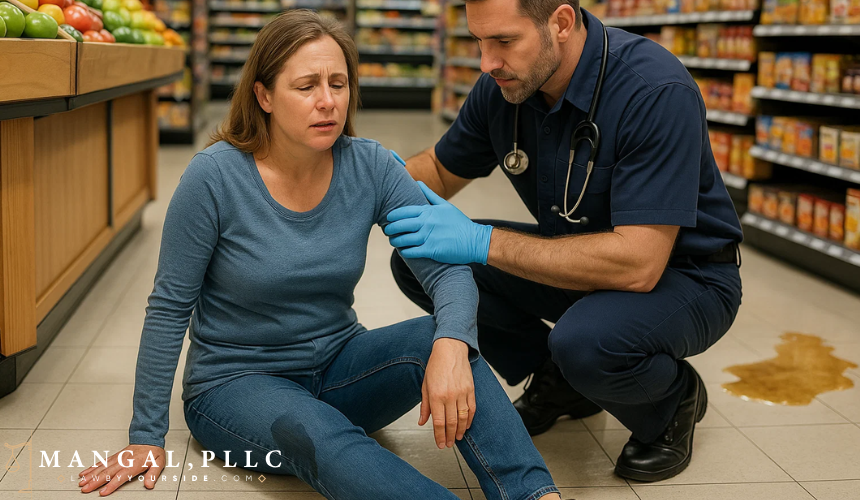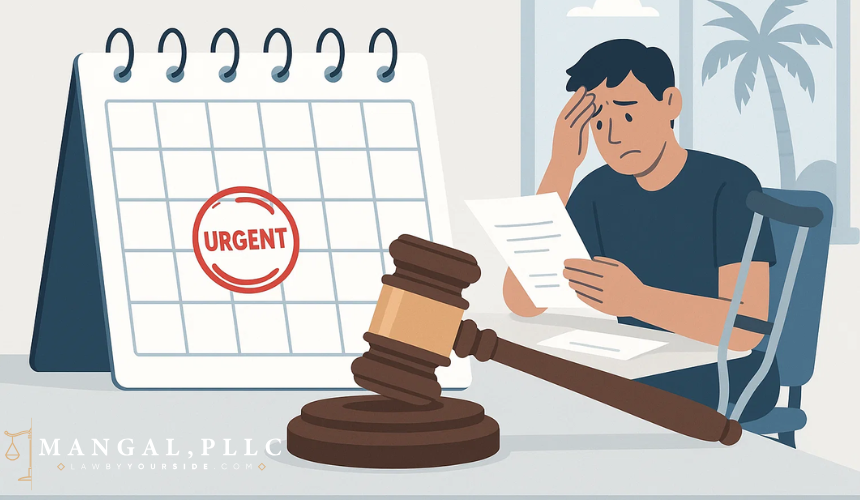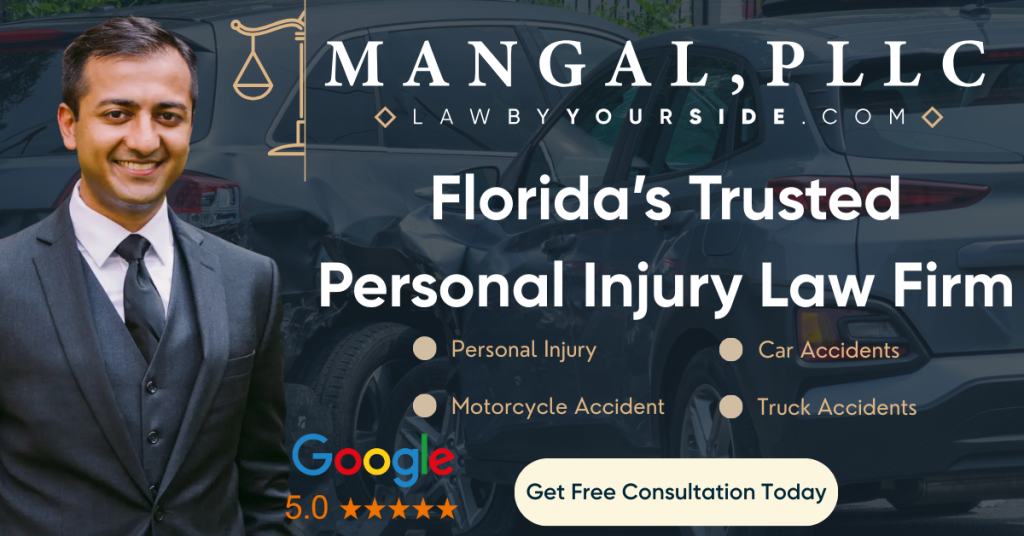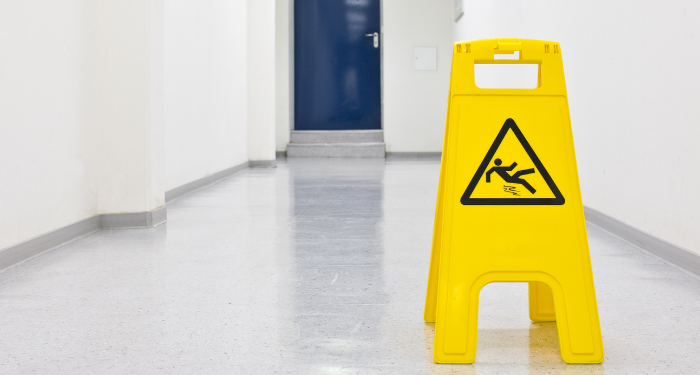A slip and fall can take place in seconds anywhere at any premises unexpectedly. Imagine that a minute before you may be walking through a grocery store or hotel lobby, and the next your foot hits something slick and you’re on the floor, getting yourself injured. Maybe it was a wet tile, a leaking ceiling, or a spilled drink that no one bothered to clean. First the embarrassment. Second, the pain. And in that moment, what you do next matters more than you think.
Slip and fall accidents are common across Florida. But proving who’s responsible isn’t simple. Florida law puts the burden on you to show that the business knew, or should have known, about the dangerous condition. That means evidence must start from the moment you hit the ground.
Our Florida personal injury attorneys at MANGAL, PLLC, explain below exactly what to do after a fall, step by step.
1. Get medical help immediately
The first mistake most people make is trying to walk it off. Don’t. Adrenaline hides pain, and what feels like a bruise might be a fractured wrist, torn ligament, or head injury. Call for help or ask someone nearby to do it for you. If you can move safely, go straight to urgent care or the emergency room the same day.

That first medical record becomes proof that the fall caused your injuries — not something that appeared days later. Follow up with your doctor, take their advice seriously, and keep every document they give you. Medical treatment is both your health protection and your legal foundation.
2. Photograph the scene right away
If you’re physically able, take photos before anyone changes the area. Florida slip-and-fall claims often turn on what the floor looked like minutes after the incident. Capture everything — the wet spot, torn carpet, loose tile, lack of warning cones, and lighting conditions.

If you slipped near an entrance, get the mat, the doorway, and the ceiling above. If someone helps you, ask them to snap pictures too. Video is even better. These few seconds of action can become the most important proof you have.
3. Identify employees and witnesses

After a slip and fall, the people who saw what happened can make or break your case. Get their details while the scene is still fresh.
- Ask for names and contact info of any witnesses, like customers, staff, or cleaners whoever was around at that time.
- Note the name and position of any employee who assisted you.
- Report the fall to the manager on duty and explain where and when it happened.
- Request that it be entered into the incident report and ask for the report number.
- Record the exact time and the manager’s name.
- Politely ask them to preserve CCTV footage and cleaning logs before they’re lost.
4. Understand the Florida rule you’re up against
Here’s the part most people don’t know: under Florida law, the burden of proof is on the injured person. You must show the business had “actual or constructive knowledge” of the dangerous condition — meaning they either knew about it or it existed long enough that they should have known.

That’s why your photos, witness names, and report details matter. They connect the dots: what caused the fall, how long it was there, and who ignored it. Without this evidence, even serious injuries can end with no recovery because there’s no proof the store was aware of the danger.
5. Florida’s comparative fault rule – don’t get blamed for your own fall
Insurance companies love to shift blame. In Florida, if they can convince a court or jury that you were more than 50% responsible, you get nothing. It’s called comparative fault.
They’ll argue you were distracted, wearing slippery shoes, or should have seen the hazard. That’s their playbook. The truth is, most people aren’t staring at the ground when they walk into a store — and the law doesn’t expect them to. Property owners must keep their premises reasonably safe, especially in areas they know get wet or dirty.

After your fall, be careful about what you say. Don’t tell anyone “I should’ve been more careful” or “I wasn’t looking.” Keep your answers factual: where you were walking, what you felt underfoot, what you noticed after. Honest, simple statements can’t be twisted later.
Your Florida slip and fall lawyer can later analyze lighting, placement, and floor texture to show why the business was still responsible — even if you weren’t perfect.
6. The Statute of Limitations – the deadline
In Florida, you generally have two years from the date of the fall to file a personal injury lawsuit. It sounds like a lot of time, but it goes quickly. Cameras overwrite footage within days. Managers leave jobs. Witnesses move. The longer you wait, the harder it becomes to prove what really happened.

If you’re not ready to file a claim yet, at least keep your paperwork organized — hospital bills, doctor notes, photos, any communication from the business or their insurer. If someone calls you offering a settlement, don’t agree or sign anything until a lawyer reviews it.
These early steps protect your right to pursue full compensation later. Acting fast also gives your attorney more leverage, because the other side knows you have evidence and deadlines on your side.
7. The “open and obvious” defense – and why it’s not always the end of your case
Businesses often argue that the danger was “open and obvious.” They’ll say anyone could’ve seen the spill or the uneven floor, so it’s your fault for not noticing. That defense isn’t always strong.

Florida law still requires property owners to maintain their premises safely. Even if a hazard is visible, the owner must anticipate that people might be distracted, carrying items, or focused on signage or checkout lines. A cracked sidewalk or broken step can still be dangerous even if it’s in plain sight.
Photos and witness statements often reveal that lighting, crowd movement, or store layout made it hard to see the risk in time. An attorney can help frame those facts properly, showing that “obvious” doesn’t mean “harmless.”
8. Your 48-hour checklist after a slip and fall

What you do in the first two days can define your entire claim. Here’s a quick guide:
- Get checked out: even mild pain could be a fracture or soft-tissue injury. Follow up with your doctor.
- Keep your clothes and shoes: don’t wash or throw them away — they might carry traces of the substance you slipped on.
- Write everything down: time, place, what you saw, who helped you, and what they said. Memory fades faster than you think.
- Go back if possible: safely revisit the spot and take daytime photos if lighting was poor earlier.
- Save your receipts: medical bills, prescriptions, transport to appointments — all become evidence of loss.
- Avoid social media: posts or photos can be taken out of context and used against you.
- Speak to a lawyer early: it costs nothing upfront, but helps protect evidence and communication from day one.
These simple steps are how strong cases are built. What feels like routine after an accident becomes the proof that wins your claim later.
9. What counts as strong proof in a Florida slip and fall case
Evidence is everything. The more you can show about how and why the fall happened, the stronger your case becomes. Florida courts look for signs that prove the hazard existed long enough that the business should have known about it.

That means:
- Footprints or cart tracks in a spill — showing it wasn’t fresh.
- Dirty or dried edges around liquid — proving it sat for a while.
- Employee routines or cleaning logs that show gaps in inspection.
- Recurring leaks from air-conditioning lines or freezer units.
- Prior complaints about the same area or defect.
A Clermont slip and fall lawyer will often send a “preservation letter” to the business to keep surveillance footage, cleaning schedules, and maintenance contracts. The earlier this goes out, the harder it is for the other side to say “we didn’t know.”
10. What not to do after a slip and fall

Certain mistakes can quietly destroy a claim. Here are the big ones:
- Saying “I’m fine” to staff or paramedics when you’re not.
- Leaving before anyone documents the fall.
- Posting online about what happened.
- Giving a recorded statement to insurance before legal advice.
- Throwing away or washing your clothes or shoes from that day.
These seem harmless in the moment but give insurance adjusters exactly what they need to devalue your case. Keep things simple: get medical care, save evidence, and speak with someone who understands Florida premises liability before saying anything else.
11. How medical bills work when it’s not a car accident
Unlike car crashes, there’s no Personal Injury Protection (PIP) coverage for slip and fall cases. Your own health insurance might cover the initial treatment, but it may later claim reimbursement if you recover money. That’s where negotiation matters.

A good slip and fall lawyer can help structure medical liens, communicate with hospitals, and ensure that final settlement funds actually benefit you, not just your insurer. This includes future care — therapy, injections, or surgery that doctors believe you may need later. Those costs form part of your damages claim.
12. Common slip and fall spots around Clermont and Central Florida
These cases happen everywhere, but some locations repeat over and over:
- Grocery stores: produce aisles, frozen-food sections, entrances during rain.
- Restaurants: greasy kitchen thresholds, restroom floors.
- Apartments: cracked stair treads, algae on walkways, missing railings.
- Hotels: slick marble lobbies, pool decks, valet ramps.
- Retail chains: freshly mopped floors without warning signs.
Every setting has its own rules, safety standards, and inspection routines — and those details are often what win or lose a case.
Frequently asked questions
Do I have a case if I didn’t see the hazard?
Yes. Most falls happen because hazards blend in — clear liquid, poor lighting, shiny floors. What matters is how long the danger existed and whether the property owner ignored it.
What if there’s no camera footage?
Cameras help, but they aren’t everything. Cleaning logs, employee statements, and photos can show how long the condition lasted.
What if I was distracted or on my phone?
You might still recover damages. Florida law only bars recovery if you’re more than 50% at fault. Being partially distracted doesn’t automatically disqualify you.
How long do I have to file?
Two years from the date of the accident for incidents after March 2023. Sooner is always safer.
What to bring when you talk to a lawyer?
To get a clear case assessment, have these ready:
- Photos or videos of the scene.
- The incident report or number.
- Names of employees or witnesses.
- All medical bills, reports, and prescriptions.
- The shoes and clothing from that day.
- Notes or a short timeline from the fall to your first treatment.
Even if some pieces are missing, a slip and fall lawyer can help track them down. What matters is that you start the process early.

Ready to talk to a Clermont slip and fall lawyer who listens?
After a fall, you don’t need to face big insurers or store lawyers on your own. You need someone who knows how Florida law really works — how notice, fault, and timing decide outcomes.
At MANGAL, PLLC, every case starts with a conversation. No pressure. No hourly fees. Just a clear review of what happened, what evidence exists, and what your next steps should be.
If your injury happened in Clermont, Orlando, or anywhere in Central Florida, help is close. The sooner you act, the easier it is to protect your rights and secure the compensation the law allows.


